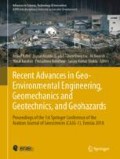Abstract
Portland cement manufacturing produces, in its exhausts, carbon dioxide, carbon monoxide, sulphur dioxide, oxygen, nitrogen, water vapour, and argon. Significant amounts of carbon dioxide and sulphur dioxide are therefore released into the atmosphere. For the purpose of minimizing the input of greenhouse and acid rain gases, ways of capturing the carbon dioxide by, for instance, mineral carbonation, are being investigated around the world. This study is a review of the masses of gases, their volumes, temperatures, and the heat energy they release. It forms the first step in determining ways for on-site carbon dioxide and sulphur dioxide sequestration. The study shows that for a tonne of clinker, the masses of the gases produced, in tonnes, are 1.2 CO2 (63%), 0.004 SO2 (0.2%), 0.008 CO (0.4%), 0.0549 O2 (2.82%), 0.5 H2O (25.8%), 0.16 N2 (0.1%) and Ar 0.0028 (0.096%). The total volume of the gases leaving the stack, if the exit temperature is 300 °C, is 2.975 m3, but reaches 4.532 m3 at 600 °C, while the heat energy potentially available for downstream use, is 1272 and 1938 MJ, again at 300 and 600 °C, respectively. This is wasted heat energy that cement companies should use to capture the gases that have negative environmental consequences.
Access this chapter
Tax calculation will be finalised at checkout
Purchases are for personal use only
References
Peray, K.E.: The Rotary Cement Kiln. Chemical Publishing Company Inc., New York NY (1982)
Tonnegu, E.L.: Limestonnee Report. Council for Geoscience, Pretoria, South Africa (2007)
British Geological Survey (BGS), Mineral Profile, Cement Raw Materials. Office of the Deputy Prime Minister (2005)
Eckel, E.C.: Cement Materials of the United States. United States Geological Survey, United States Department of the Interior (1905)
Taylor, H.F.W.: Cement Chemistry. Academic Press, London (1990)
Wright, J.B.: Constructional and Other Bulk Materials. The Open University Press. Miltonne-Keynes, UK. 88 p (1974)
Sanna, A., Uibu, M., Carmanna, G., Kussik, R., Maroto-Valer, M.M.: A review of Carbonation Technologies to Sequester CO2. Chem. Soc. Rev. 48, 8049–8080 (2014)
Zevenhoven, R., Fagerlund, J.: Mineralisation of carbon dioxide (CO2). In: Maroto-Valer, M.M. (ed.) Developments and Innovation in Carbon Dioxide (CO2) Capture and Storage Technology, pp. 433–462. Woodhead Publishing Ltd, Oxford (2010)
Hogan, C.M.: Abiotic factor. In: Monosson, E., Cleveland, C. (eds.) Encyclopedia of Earth. National Council for Science and the Environment. Washingtonne DC (2010)
Author information
Authors and Affiliations
Corresponding author
Editor information
Editors and Affiliations
Rights and permissions
Copyright information
© 2019 Springer Nature Switzerland AG
About this paper
Cite this paper
E. D. Senzani, F., F. Mulaba-Bafubiandi, A. (2019). Portland Cement Exhaust Characterization and Its Potential Use in Mineral Carbon Sequestration. In: Kallel, A., et al. Recent Advances in Geo-Environmental Engineering, Geomechanics and Geotechnics, and Geohazards. CAJG 2018. Advances in Science, Technology & Innovation. Springer, Cham. https://doi.org/10.1007/978-3-030-01665-4_16
Download citation
DOI: https://doi.org/10.1007/978-3-030-01665-4_16
Published:
Publisher Name: Springer, Cham
Print ISBN: 978-3-030-01664-7
Online ISBN: 978-3-030-01665-4
eBook Packages: Earth and Environmental ScienceEarth and Environmental Science (R0)

